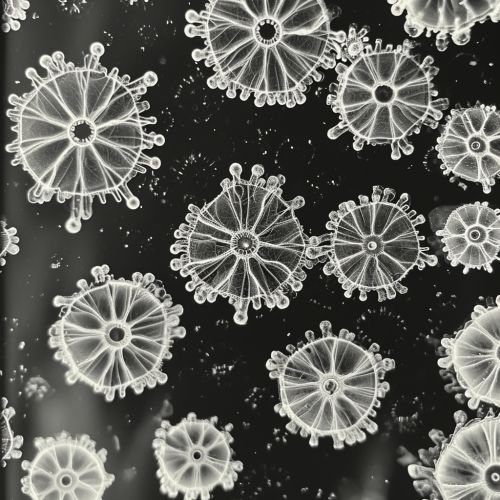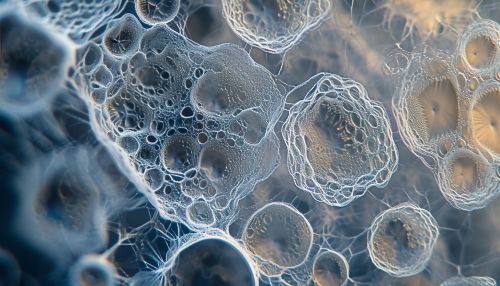Radiolaria
Introduction
Radiolaria are a type of protist, a diverse group of eukaryotic microorganisms. They are characterized by their intricate mineral skeletons, which are typically composed of silica. These skeletons are often beautifully symmetrical and are used by scientists as index fossils to date rock formations. The study of these organisms falls under the domain of micropaleontology.


Morphology
Radiolaria possess a unique morphology that sets them apart from other protists. Their cell structure is divided into inner and outer sections by a central capsule, which is a distinguishing feature of this group. The outer section, or ectoplasm, contains pseudopodia that extend through openings in the capsule. These pseudopodia form a complex network outside the cell, which is used for capturing food particles. The inner section, or endoplasm, contains the cell's nucleus and other organelles.
Skeleton Structure
The skeletons of Radiolaria are their most striking feature. They are composed of silica and are incredibly intricate, often displaying a high degree of symmetry. These structures are formed by the organism secreting silica from the endoplasm, which then solidifies to form the skeleton. The shape and structure of these skeletons can vary greatly between different species, ranging from simple spherical forms to complex geometric shapes.
Ecology
Radiolaria are predominantly marine organisms, found throughout the world's oceans. They are an important part of the marine food chain, feeding on small phytoplankton and other microscopic organisms. In turn, they are preyed upon by larger zooplankton and other marine creatures. The silica skeletons of Radiolaria sink to the ocean floor after the organism dies, contributing to the sediment and playing a crucial role in the marine silica cycle.
Classification
Radiolaria are classified under the supergroup Rhizaria, which also includes other amoeboid protists with complex shells, like foraminifera and heliozoans. They are further divided into two main classes: Polycystinea and Acantharea. Polycystinea are characterized by their intricate silica skeletons, while Acantharea have skeletons composed of strontium sulfate.
Fossil Record
Radiolaria have a rich fossil record dating back to the Cambrian period, over 500 million years ago. Their silica skeletons are well-preserved in sedimentary rock, providing a valuable resource for paleontologists. The presence of specific Radiolaria species in rock formations can be used to date these formations, a practice known as biostratigraphy.
Scientific Importance
Radiolaria are not just of interest for their aesthetic appeal; they are also of significant scientific importance. Their extensive fossil record provides valuable data for paleoclimatology, the study of ancient climates. Changes in Radiolaria species and distribution over time can provide clues about historical climate conditions and oceanic circulation patterns.
